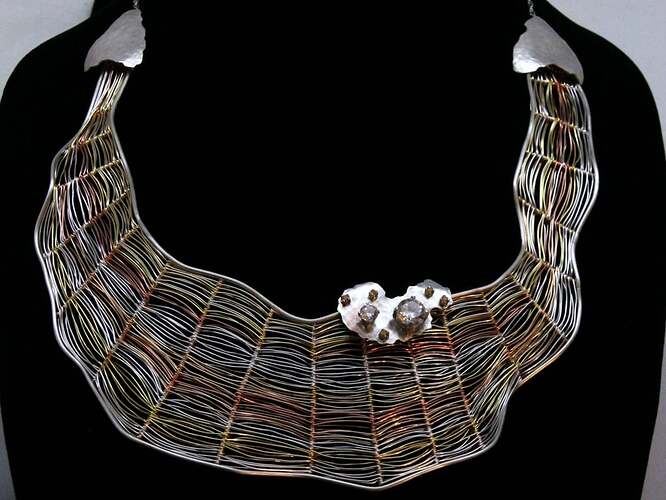Materials: Argentium, Sterling Silver, copper, brass, created yellow saphire, cubic zirconia, sterling silver chain
Dimensions: Wire Structure: width 6.5" , length 7", chain measures 8.5", 2 mm yellow topaz, 8 mm cubic zirconia, metal tabs 1" , metal tab with stones 1.25"
This necklace is inspired by sunlight and it is the third in an ongoing series.
Photo credit: Kenneth Loshelder
Ashley Jay
Denton, TX. USA
I love working with my hands. Having an idea and watching it change and evolve into its final form through the creative process is always an exciting, inspiring and challenging endeavor. It is my privileged to work with metal, gemstones, and all things shiny! Designing beautiful pieces of jewelry that are fun to wear is my goal as an artist. I strive to do my best with each piece. I have been making jewelry my whole life but it has been in the past decade that it has slowly become a most ardent passion and my chosen career path. My first teacher was my mother, and since then I have had the privilege of working with many fantastic metalsmiths through the University of North Texas, where I earned my degree in metaslmithing and jewelry design. I am inspired by the women and men around me, the nature we exist in, and the richness and beauty found in colors.
The exhibition explores metal works whose primary theme is color embraced as their primary visual focus, whether that be using colored materials, exploring creating colored surfaces, or encasing the object in color.
As the world's largest jewelry related internet site, Ganoksin strives to develop exhibitions showcasing work from around the world. This exhibition was open to all metalsmiths, professional and amateur, advanced and beginner.
In total 303 artists contributed 814 show pieces for the permanent online exhibition.
The exhibition was curated by Beth Wicker, President of the North Carolina Society of Goldsmiths in the United States, and Adjunct Instructor at Northeastern Technical College in South Carolina. Director of the exhibition is Hanuman Aspler, founder of The Ganoksin Project, the world's largest internet jewelry site.
Hue is one of the primary properties of color, it refers to the place the color occupies on the visual spectrum. Humans have used hues throughout time, to create cave paintings, to decorate themselves, their clothing and their housing.
Different hues have taken on different meanings throughout time. Gold traditionally has been a color of purity - the metal gold is relatively unchangeable, and the hue of gold has come to stand for gods and goddesses, for royalty, for durability and for purity. Red has often meant love, or passion. Hues often reflect the meaning of the seasons, with pastels referring to spring and the burst of new life after the pale hues of winter. Summer is reflected in vibrant, deep hues, followed by the browning of hues in the fall as plants go to seed and die, and the land turns fallow.
The worth of a hue has often been tied to what is necessary to make the pigment that creates the hue, and the expensive involved in the process. Often created from crushed stones that had to be mined and carried by caravan over thousands of miles, or from fermented roots of plants only grown in certain areas, or the carapaces of rare insects - the creation of hue in a way that could be used by man was an involved and generally expensive process.
In today's world metalsmiths have access to perhaps the widest range of materials and hues in the history of man - and in some of the most affordable ways ever.
This exhibition celebrates hue - color - as an integral, inherent element of the work. We talk of the "richness" of color, and examples of this abound here. One expects hues from the colors of gemstones used in metalsmithing, but we also have hues from some less expected places. Glass enamels are an ancient way of adding color, as are a variety of patinas. Today's artists also use synthetic man-made materials to add color in ways that didn't exist a century ago.
We invite you to enjoy this celebration of hue, and the ways hues and their use have changed over time.
